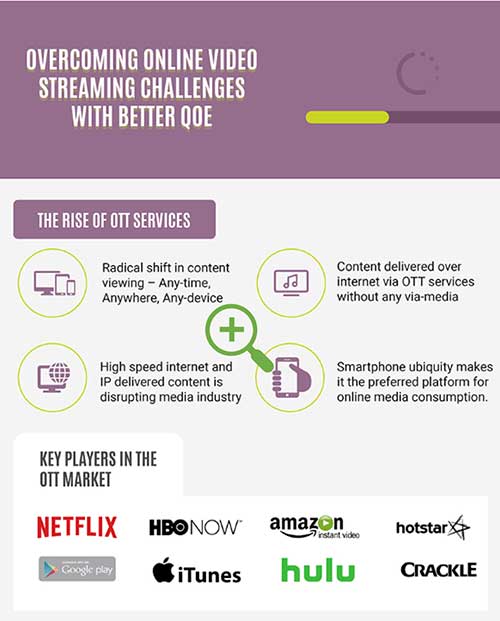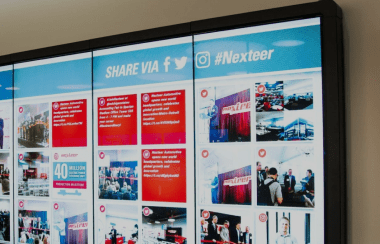The limitless combinations of device, network, content, and places suggest that the stream reaching you at a given point may be navigating through uncharted territory. This means that the QoE of your online video stream depends on a number of factors.
To overcome challenges in the OTT (Over-the-top content) environment, offering an outstanding quality of experience (QoE) is crucial. Viewers desire the same level of quality for online streaming as they get with the conventional cable or satellite services.
It is extremely annoying to get the infamous rebuffering screen and not knowing who to complain about resolving the issue. In the case of online video streaming, accountability is a tricky subject. However, we can define a few metrics that revolve around the quality of experience for online video streaming. These QoE report cards are now offered by a few content providers, including Netflix and Google.
QoE of Online Video Streaming
At present, quality of experience is rooted in a network that covers these elements:
- Application and Device – Client application and its compatibility with the device
- CDN – Performance of video cache
- User Behavior – Client app and consumer interaction with the device
- Network Operator – Congestion, Capacity, and performance from the Content Distribution Network to the user’s device
- Content – Quality and resolution of video and then encoding
This back-to-back view has to be simplified for reducing the dilemma of delayed online streaming to a few simple metrics that are quantifiable and can be monitored easily.
Most experts observe that the following streaming metrics have a major effect on the QoE of online video streaming:
- Start Buffering Time: Duration between the click of the ‘play’ button and the beginning of the video
- Mediaplayer Error: Errors during video playback
- Average Bitrate: Average bits per second for streaming
- Rebuffering Time: Total buffering time throughout the playback
To simplify things further, reputed content providers including Netflix and YouTube along with some well-known ISPs have paid close attention to the Average Bit Rate as a revealing metric in OTT Quality of Experience.
This bit rate varies for every video that is streamed, owing to a viewing screen, the resolution, network congestion and the bandwidth available in the network path. When it comes to ABR (Adaptive Bit Rate) streaming, the rate alters because of the network congestion during the stream.
Hence, at a point of time when multiple videos are streamed, the average Bitrate for a particular operator is the best measure of viewing experience for consumers.
Out of the three core metrics, the Average Bit Rate is the most accurate indicator of video quality. This is because a higher average bitrate means higher resolution streams without many rebuffering events. Not just that, it is easily calculated and can be consistently reported.
The ease with which subscribers can stream videos triggers the downloading of far more data than actually required. Subscribers end up streaming online videos that they may never view at all. This leads to severe network bottlenecks.
However, today’s tech-savvy subscriber wants to stream videos at the maximum available download speed and does not tolerate buffering.
It is important for online video publishers to select appropriate key metrics to sustain their business growth. In light of this, there are two metrics that they should consider:
Viewhour
This refers to how long users watch online videos. The metric has an incredible implication on how content providers utilize their resources to make the most of the audience engagement. Increasing viewhour leads to more revenue for ad-supported businesses. This is because content providers can play more ads during playback.
Getting to know how video streaming quality influences viewhour helps make the best decision for future investments, even with limited resources to maximize engagement.
Engagement Analysis
Video consumption patterns help video publishers to get to know more about their audience. This information is used to drive monetization by calculated ad placement and for customizing future videos, resulting in more engagement.
All stages of streaming continue to evolve; from broadcast to streaming video. Even though all crucial and relevant metrics are now defined, the lack of accountability and negative reporting affects the Quality of Experience for streaming videos online.
Final Thoughts
There is still a lot more to do for overcoming the many challenges that online video streaming continues to encounter. We hope to devise an online tool that would measure the QoE of a content source when streaming across a mobile or broadband connection in real-time.
Ideally, this detailed report should also be able to assess if our service providers are heading in the right direction. At present, the real challenge is to make sense of the countless combinations of ISPs, devices, and content providers that are involved in creating a consumer-friendly online experience.
Sources
- https://qwilt.com/making-sense-of-streaming-video-quality-of-experience/

Product Engineering Services Customized software development services for diverse domains
Quality Assurance End-to-end quality assurance and testing services
Managed Services Achieve scalability, operational efficiency and business continuity
Technology Consulting & Architecture Leverage the extensive knowledge of our Domain Experts




